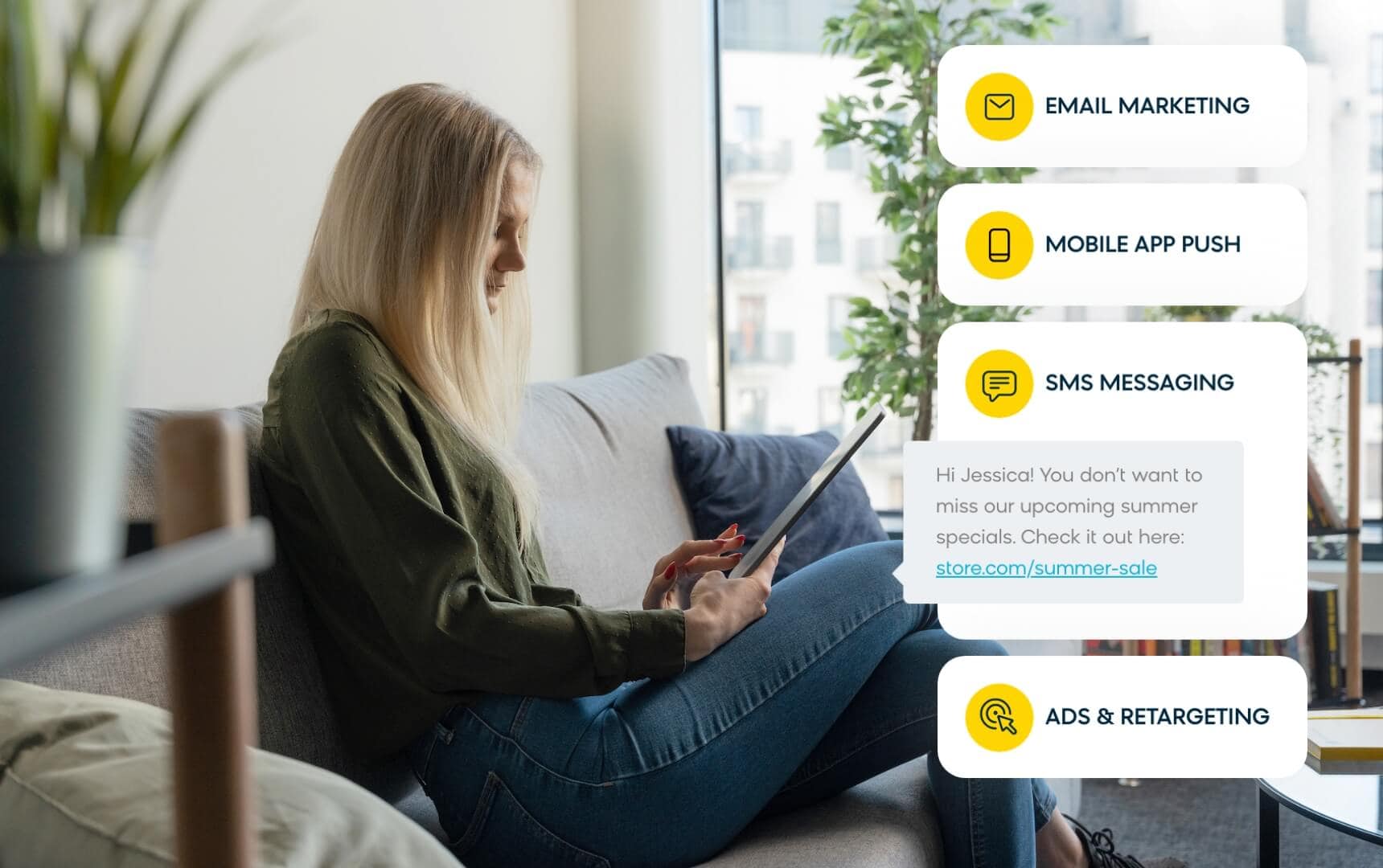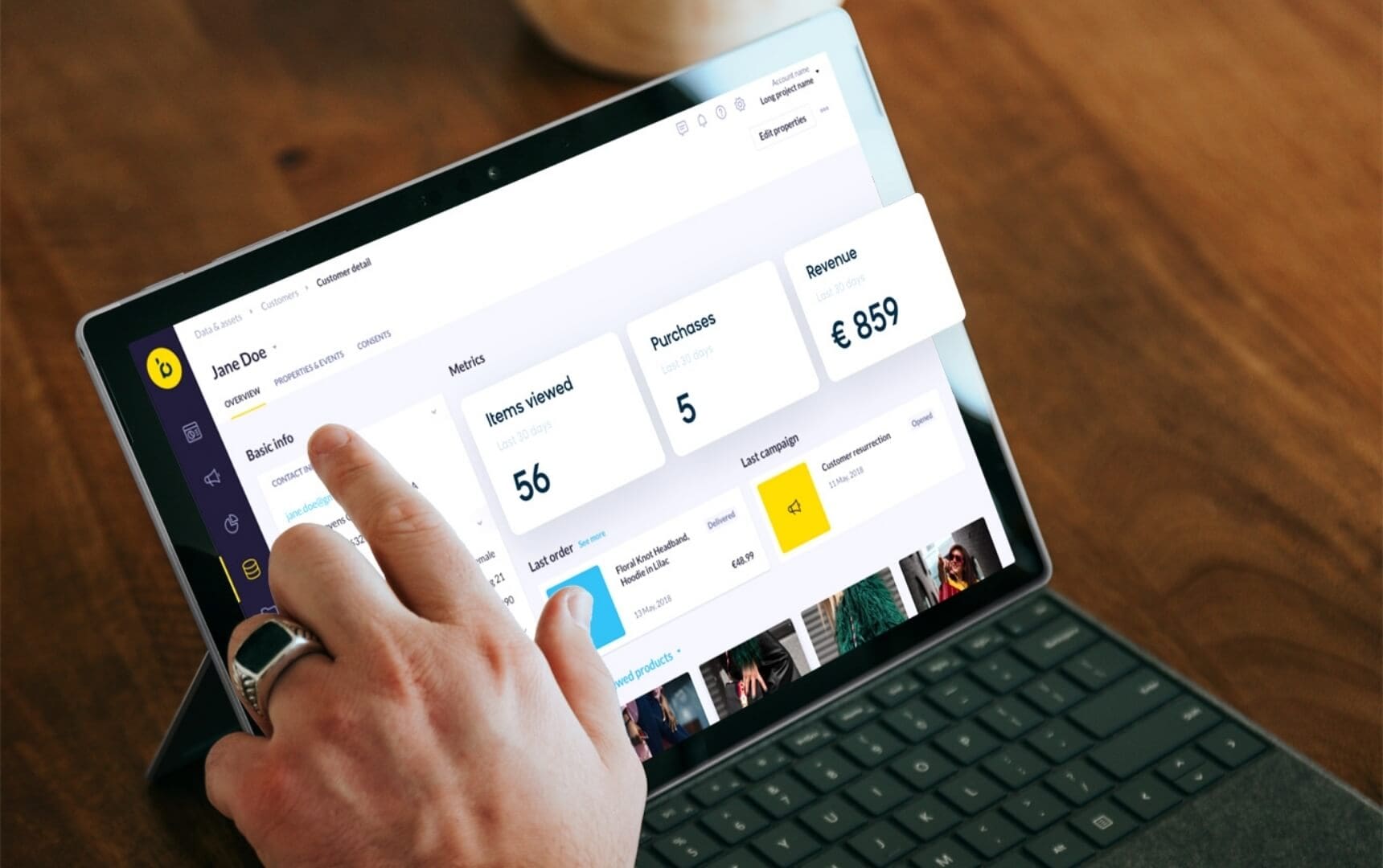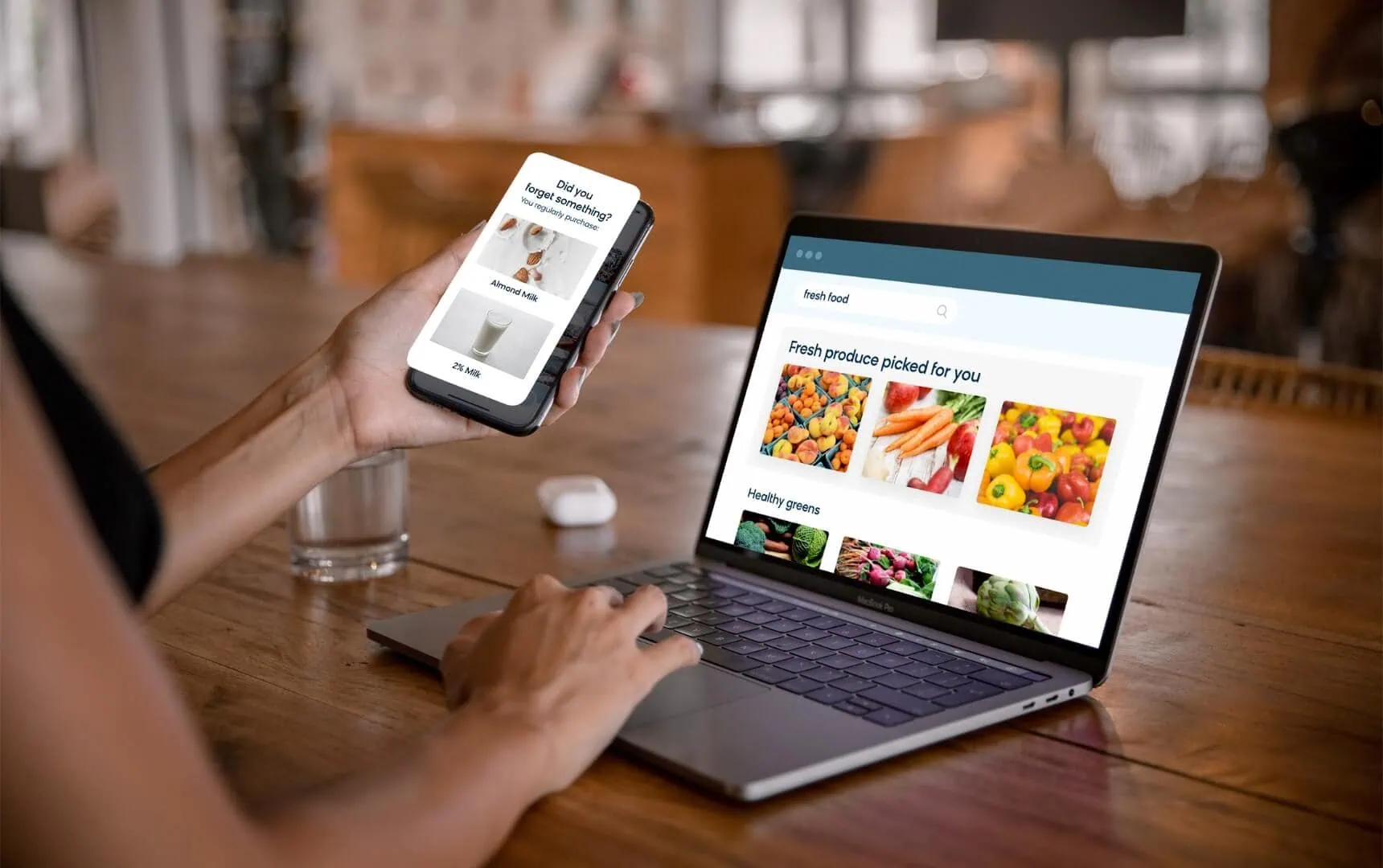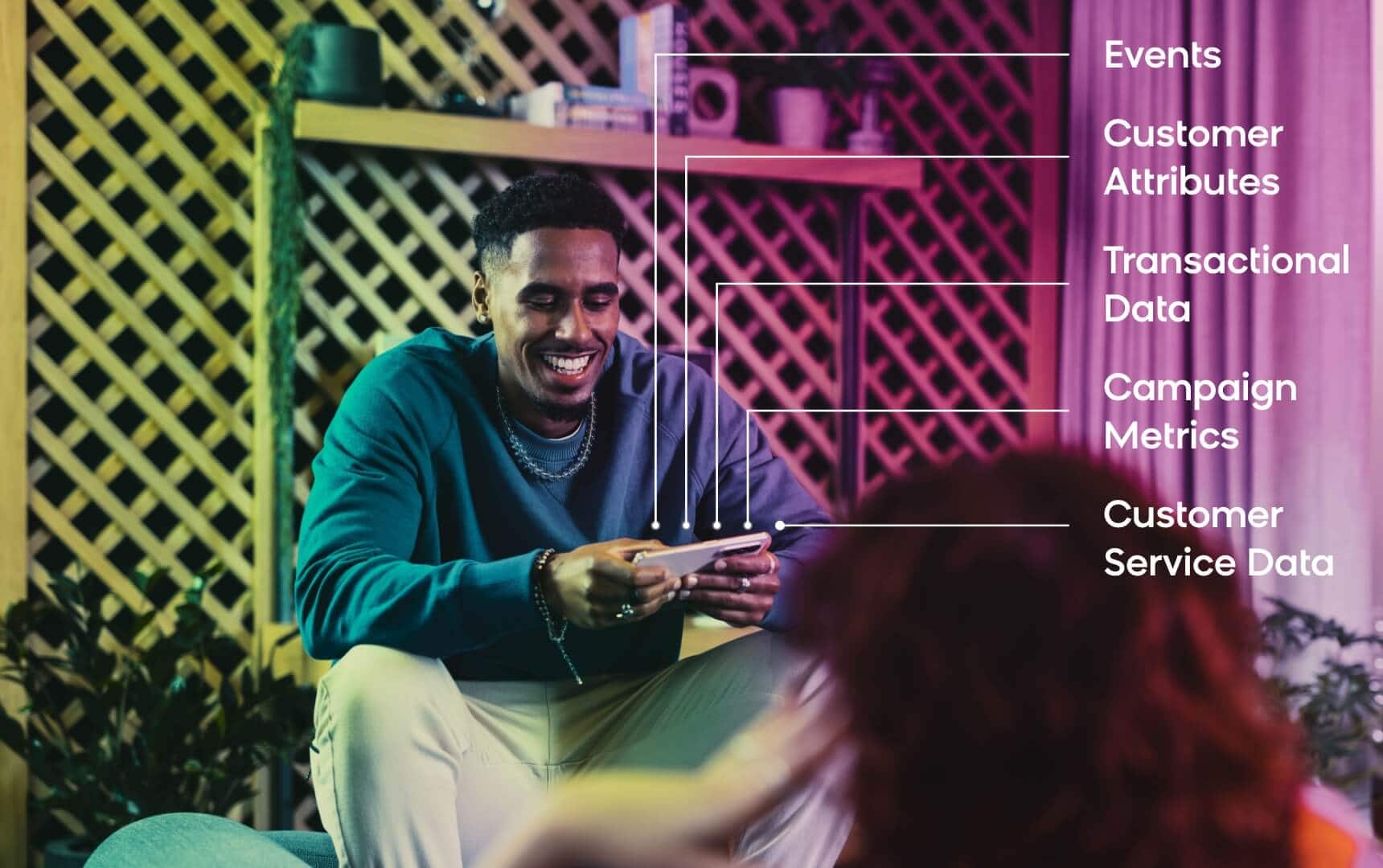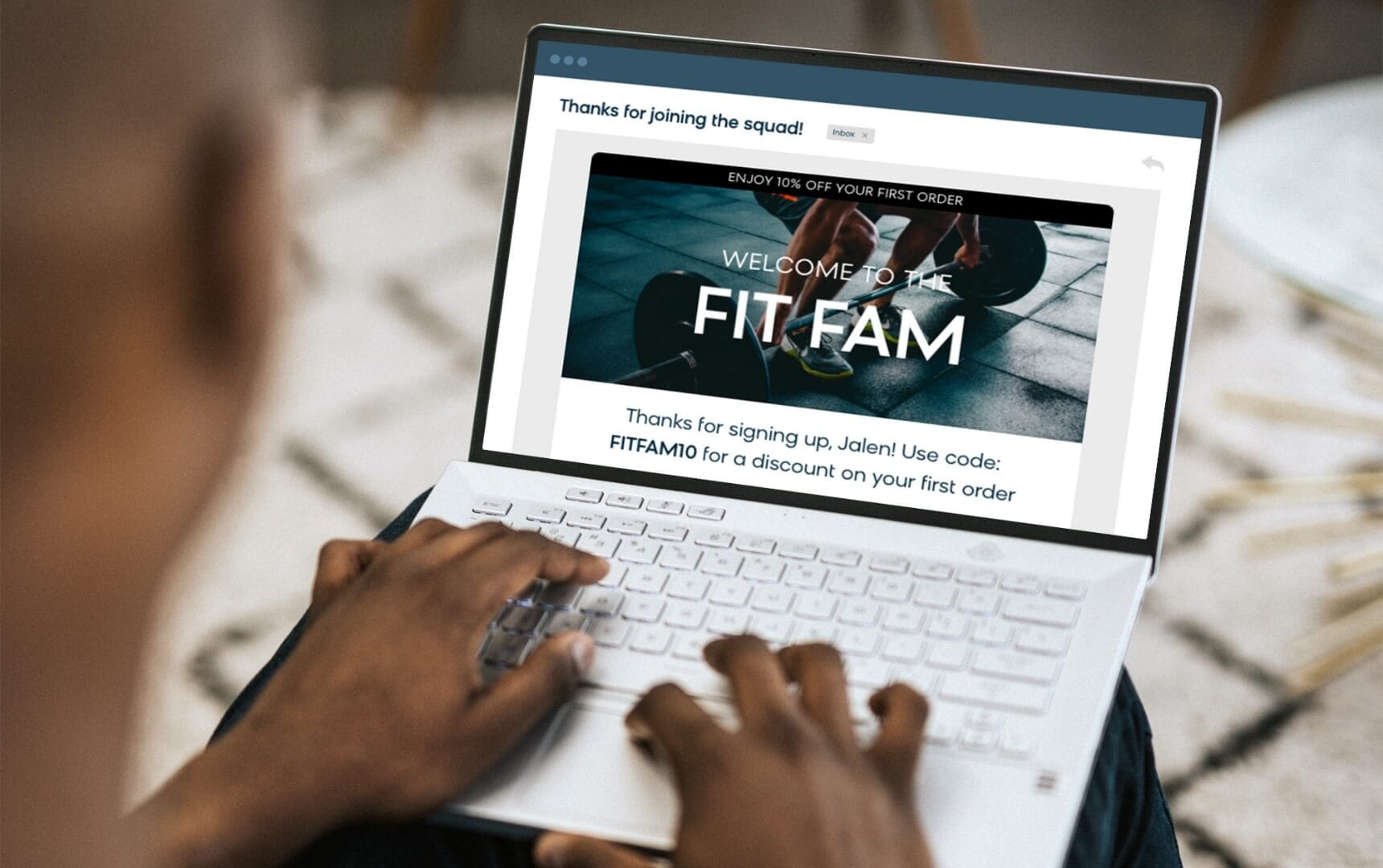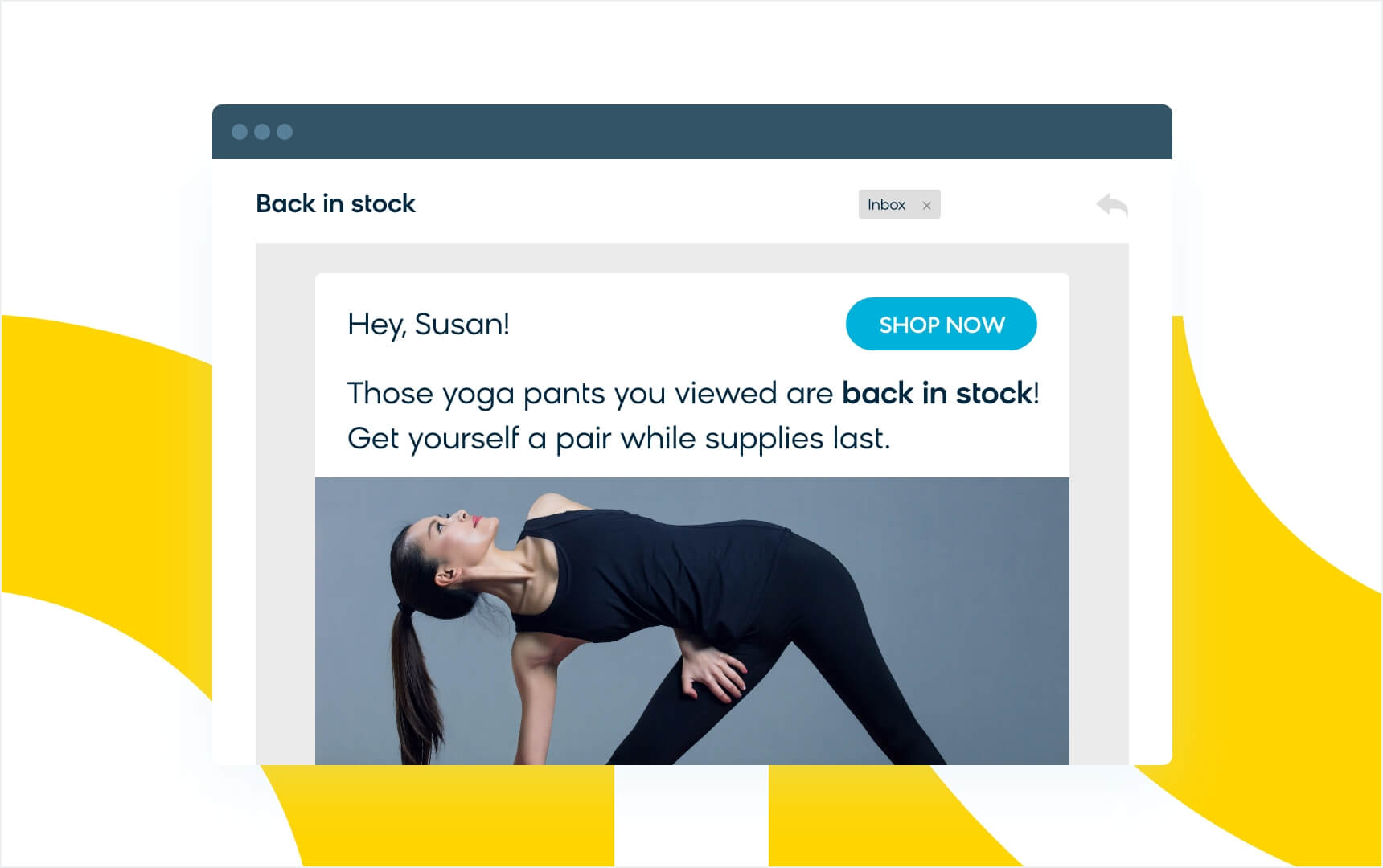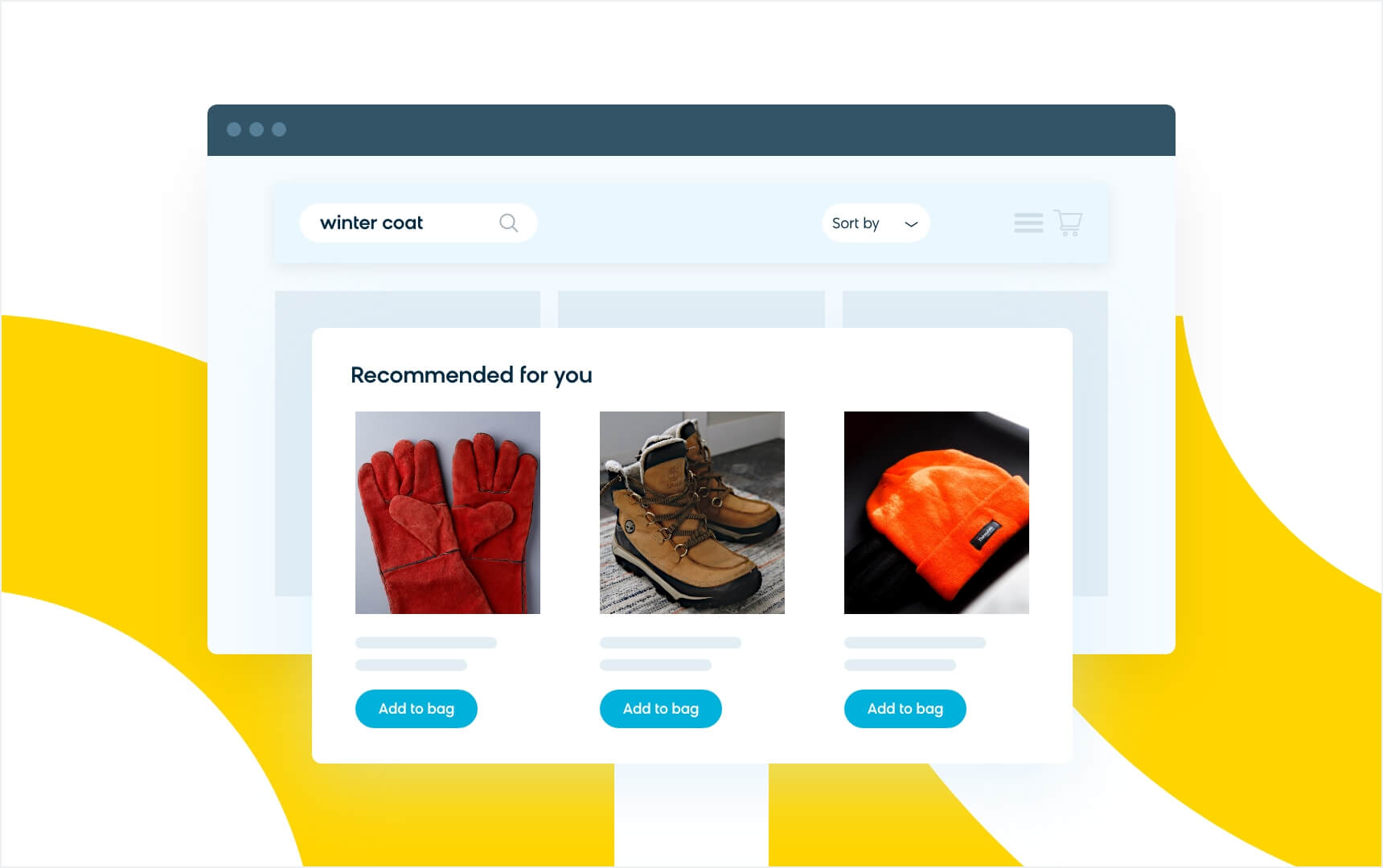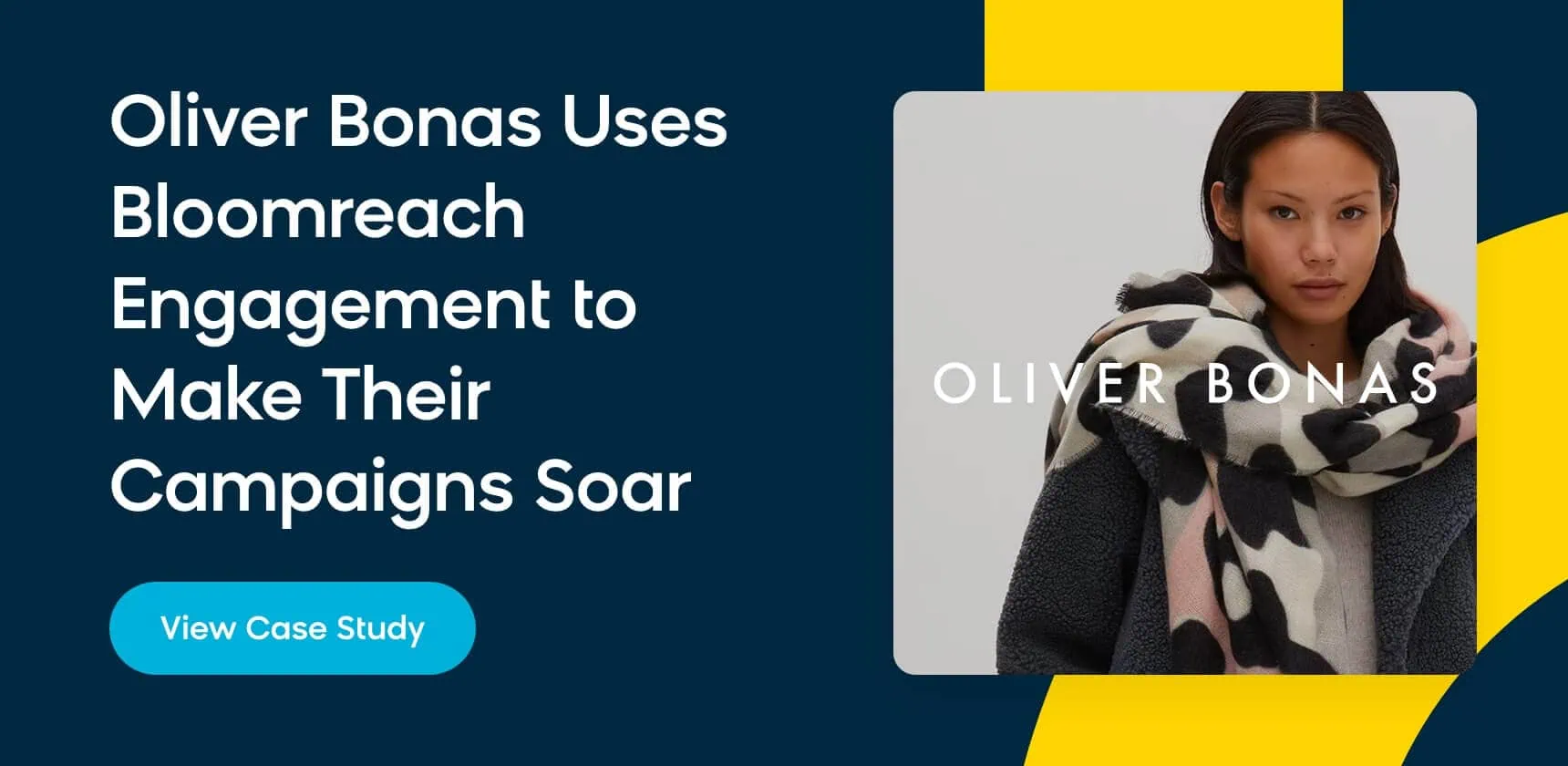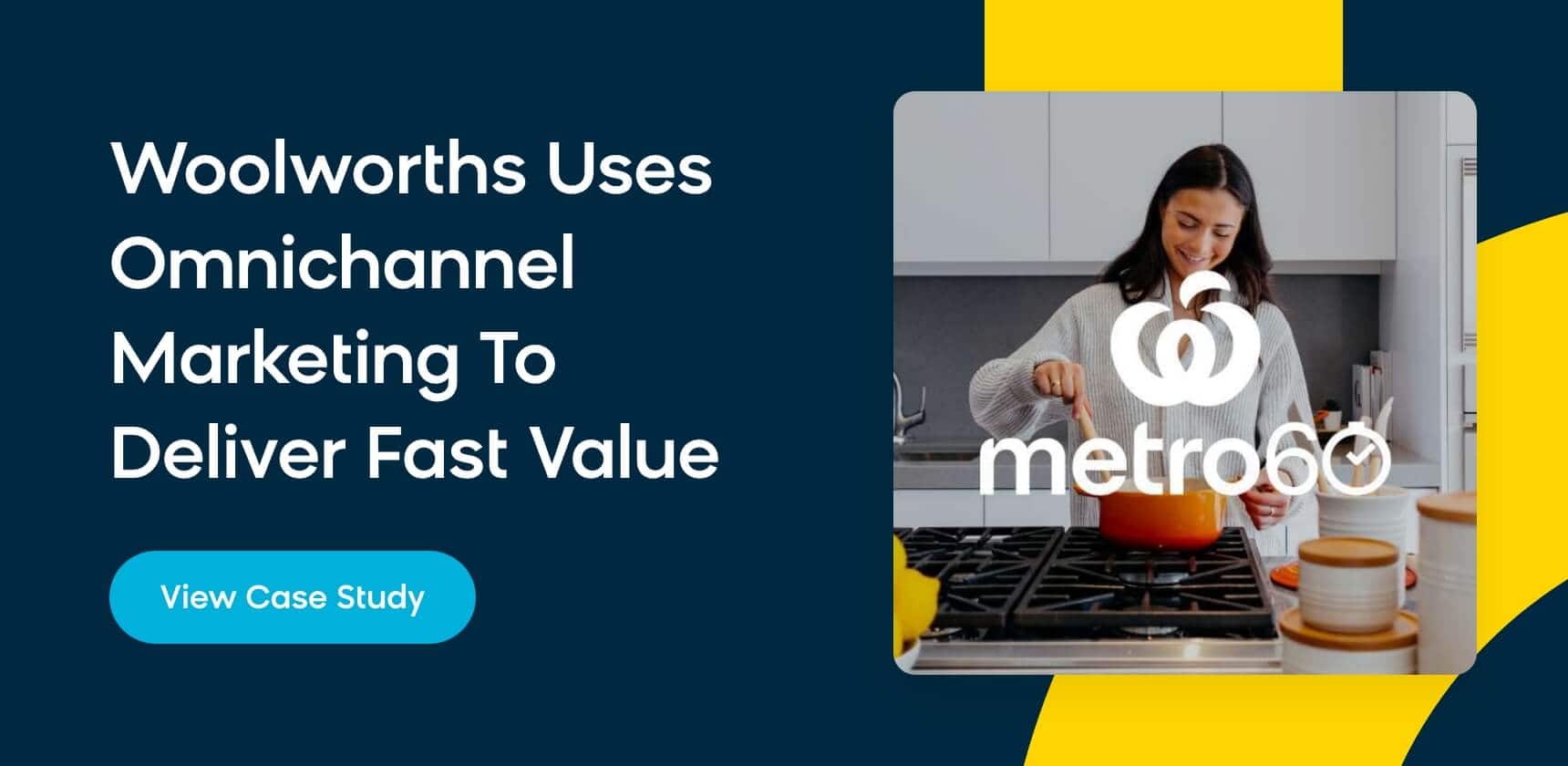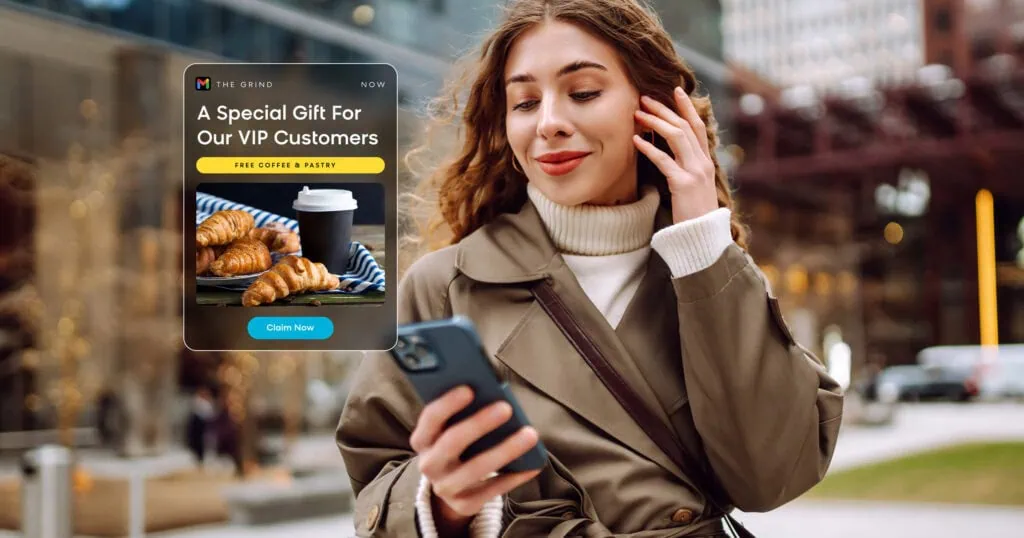Is an omnichannel personalization platform penciled into your priority list this year?
It certainly deserves a spot. Personalization accelerates ecommerce business growth. According to McKinsey & Company, companies that grow quickly earn 40% more of their revenue from personalized marketing than peer brands that grow more slowly.
By leveraging insights from customer behavior, omnichannel personalization empowers marketers to deliver highly relevant messages across multiple channels. In doing this, ecommerce companies create a consistent brand experience and build deeper relationships with customers, which encourages long-term loyalty and conversions.
An omnichannel personalization strategy is ideal for businesses eager to stay ahead of the competition and deliver a truly differentiated customer experience. Read on to learn everything you need to know about boosting your marketing strategy with omnichannel personalization.
- Omnichannel marketing is all about creating a personalized, consistent experience across all channels, including email, SMS, web, and ads.
- The benefits of omnichannel personalization can include higher conversions, average order value (AOV), customer loyalty, and customer retention.
- Run omnichannel campaigns around onboarding, abandoned carts, reengagement, and upsell and cross-sell opportunities to drive revenue.
What Is Omnichannel Personalization?
Omnichannel personalization involves personalizing your communications across all of the channels you use to connect with your customers.
This includes the in-store and in-app experience, the way your customer interacts with your website and social media accounts, and the text messages, emails, and push notifications they receive from you.
Omnichannel strategy is all about delivering experiences that are relevant, timely, and valuable to the customer, while also maintaining consistency across any device being used. Ultimately, the goal of omnichannel personalization is to create a seamless, cohesive customer experience that deepens relationships, increases your marketing intelligence, and accelerates revenue.
What Are the Benefits of Omnichannel Personalization?
Customers and brands alike love omnichannel personalization because the practice ensures that every marketing touchpoint is timely and relevant.
There are countless advantages to omnichannel personalization, including:
More Connected Customer Experiences
Did you know that 88% of customers worldwide say that the experience a brand provides is just as important as the goods or services being sold?
When you nail personalization across your channels, you’ll greatly improve the entire customer journey. Everything will feel smoother and more connected. Just bear in mind that, in order to get personalization right, you’ll need unified customer data.
This is data that’s collected from various, sometimes fragmented sources and joined into one central dashboard. This provides your company with one single, reliable source of truth.
Unfortunately, not all customer data platforms (CDPs) are built equally. Many CDPs fail to offer a user-friendly interface or determine which exact actions will drive revenue. In order to unify customer data, build and analyze personalized customer experiences, and power real-time actions, you’ll need something like Bloomreach’s customer data engine.
With a data core built with marketers in mind, our customer data engine can work in conjunction with your existing customer data platform or help you start from scratch to really connect the customer experience in real time.
Improved Conversions
Put yourself in your customers’ shoes for a moment. Would you rather shop with a brand that remembers your styling preferences and always sends you a coupon on your birthday, or a brand that fails to personalize your experience, never sends you thoughtful incentives, and generally makes you feel like just a number instead of a valued customer?
Personalized experiences aren’t a “nice-to-have” for today’s customers. They’re rapidly becoming an expectation in a world where 56% of global customers feel like most brands treat them as “just a number.”
When you offer these personalized experiences to customers, your conversion rates will increase. Not only will you snag that initial sale, but with continued personalized journeys, you can capture customer engagement over the long term.
Higher Average Order Value (AOV)
Speaking of continued conversions and purchases, omnichannel personalization can encourage customers to buy more with each order. That’s because customers are more likely to trust (and purchase) recommendations from a brand if they feel that the brand truly understands their needs.
When businesses provide personalized recommendations across the multiple channels where customers are most likely to engage, they increase customer engagement and build customer loyalty, leading to repeat purchases and higher average order value (AOV).
An omnichannel strategy is particularly important if higher AOV is what you’re after (and who isn’t?). The reason for this is that your customers’ AOV differs based on the device they use.
American shoppers tend to spend more on desktop computers ($155.75 per order) than smartphones ($112.29) and tablets ($95.51). With these numbers, it’s no wonder why ecommerce marketers spring for an omnichannel approach — they can capture their customers wherever they are.
Improved Customer Loyalty and Retention
Want more repeat customers? Prioritize personalization. 78% of customers say that they’re more likely to become repeat buyers after receiving personalized content from a brand.
Personalized marketing makes customers feel valued and seen as individuals, rather than a face in the crowd of your target audience. By delivering personalized omnichannel messaging, brands kickstart a fruitful cycle in which customers feel recognized, demonstrate increased brand loyalty and repeat business, and drive higher customer lifetime value (CLTV).
Customer lifetime value is important for ecommerce businesses because it can help you forecast the long-term value of each customer and prioritize customer acquisition and retention efforts. When you properly understand each customer’s CAC LTV calculation, you can allocate resources to the customers who are most valuable to the business and, in the process, get the most bang for your buck.
How To Get Started With Personalizing Across Channels
Ready to devise your own omnichannel personalization strategy? When it comes to omnichannel marketing, don’t overlook these steps:
Unify Your Customer Data
When customer data is fragmented, it can be challenging for marketers to get a complete picture of each customer journey and deliver personalized experiences. That’s why collecting data and then unifying it is so important.
By bringing together customer data from various sources, such as purchase history, website behavior, and social media activity, marketers can gain a comprehensive view of each customer and their unique buying patterns and behaviors.
With a single, unified customer view, marketers can deliver more relevant, targeted messages, improving the customer journey and strengthening the customer relationship. Additionally, unified data makes it easier for marketers to track the effectiveness of their marketing campaigns and make data-driven improvements, leading to increased customer engagement and sales.
Make Sure Your Channels Are Aligned
Once you’ve brought all your data together, the next big step is to make sure that your channels can work together. When your channels work together, you can create a seamless customer experience across multiple touchpoints that’s informed by the data gleaned from previous interactions.
However, aligning your marketing channels can come with its own set of challenges. It requires a deep understanding of your customers, their preferences, and behaviors, as well as the technology and data needed to track and analyze the customer journey across multiple channels.
You’ll want to make sure you’re using an omnichannel personalization solution that seamlessly connects your data across all your channels (not just multiple channels — all of them) in real time. Only then can you create truly impactful personalization at scale for your customers.
Test Into Success
Testing your strategies is crucial because it helps you evaluate the impact of your personalization efforts and determine what’s working and what’s not. By regularly testing different approaches against your key metrics, you can improve the relevance and effectiveness of your campaigns and better engage your customers.
One popular testing method is A/B testing, which compares two or more versions of a webpage, email, or the like among different segments of customers. The version that best achieves the desired income — more opens, for example — is the one that gets sent to the lion’s share of customers.
But, there’s another, better way to test your omnichannel personalization. Contextual personalization uses machine learning and artificial intelligence (AI) to help your marketing team decide which message is most likely to hit the sweet spot with each individual customer.
With A/B testing, you send the best version of an email or landing page to most of your customers. But with contextual personalization, you can get way more specific and give each customer exactly what they’re looking for, exactly when they want it.
By aggregating your end users’ relevant activity, such as the emails they’ve opened or the digital ads they’ve clicked on, the AI can immediately select the variation of an email, banner, or other activity that’s most likely to result in conversions. As a result, you can get more flexibility and speed with your revenue goals, all while boosting customer satisfaction and reducing customer acquisition costs (CAC).
Omnichannel Personalization Campaign Ideas
There are several different kinds of omnichannel marketing campaigns, each with its own goal and strategy. Here are some of the top campaigns that have been proven to drive success.
Welcome or Onboarding Series
You’ve got a new subscriber! Why not reach out and say hi?
A welcome or onboarding series serves to introduce your new customer to your community and offer something to encourage them to take the next step along the buyer’s journey.
In an email environment, a welcome series can look like this:
- An initial email, welcoming the new subscriber to your community and letting the new customer know what to expect from your communications.
- A second email to prompt the customer to make a purchase or book a service. Recommend products, provide a coupon code, or share success stories from other customers.
- A third email that adjusts based on where the customer is in their journey. If a purchase was made after the second email, this email should direct the customer to follow your brand on social media and/or download your app. This touchpoint can also remind your customer to take action following the second email.
A welcome series certainly isn’t confined to the inbox, though. Consider welcome text messages, push notifications, or even paid ads. You can also initiate an onboarding experience in your app. Consider these best practices to get started on the right foot.
Abandoned Cart Campaign
Can you believe that nearly 70% of all shopping carts are abandoned? That’s right — out of every 100 filled shopping carts, only 30 of them are actually making it through checkout.
And, that’s just on desktop computers. For mobile users, the number of total abandoned carts shoots up to 86%.
Abandoned cart campaigns help you recover lost sales by reengaging customers who have left items in their shopping carts without completing the purchase. Cart recovery emails have an open rate of 45% and a conversion rate of 11%, so they’re a worthy investment for your ecommerce business.
A typical abandoned cart message will remind shoppers of the items they’ve left behind and provide an incentive to complete the purchase. Abandoned cart campaigns can be distributed through multiple channels such as email, paid ads, SMS, and push notifications.
A few smart ways to use cart recovery messaging:
- You can send follow-up emails to customers who have abandoned their carts with personalized product recommendations and discounts.
- Paid ads can lure users with abandoned carts back to your website to finish the purchase. These ads can be shown on high-traffic websites like Google or Instagram.
- Initiate SMS campaigns to contact customers who have left items in their cart. You’ll have even more success if you offer a discount to sweeten the deal.
- Push notifications can remind customers about their abandoned carts on your website or mobile app. These notifications can include incentives to complete the purchase.
Reengagement or Win-Back Campaigns
Omnichannel personalization plays a key role in reengagement or win-back campaigns by allowing marketers to deliver targeted, relevant messages that resonate with inactive customers and encourage them to reengage with the brand.
By leveraging data gleaned from the customer journey — like purchase history, website behavior, and engagement history — marketers can use strategic omnichannel marketing messaging to rekindle the customer’s interest in the brand and drive reengagement.
Win-back campaigns can be used for email, web, and paid ads in the following ways:
- Send email campaigns to inactive customers to reengage them and entice them to make the purchase
- Deploy targeted landing pages or weblayers on your website to offer exclusive deals to previous customers
- Run digital ads displayed across popular websites to catch the eye of lapsed customers and offer them personalized discounts
Reengagement campaigns can feel tricky. After all, what if you don’t nail your attempt to win back a customer’s business? Don’t worry — we’ve put together a whitepaper detailing the art of win-back campaigns and a few approaches that have worked for Bloomreach clients.
Upsell or Cross-Sell Opportunities
Another great use case for omnichannel personalization is for upsell and cross-sell opportunities. Using intel from customer preferences and past purchases, marketers with an omnichannel strategy can create personalized recommendations that are most likely to result in a purchase. According to a HubSpot survey, upselling and cross-selling boosts revenue by as much as 30%.
Imagine that your customer is shopping for a winter coat. You want to sell either one of your own branded coats or a pricier, higher-margin option to your customer, so you adjust your sidebar of recommended items to display coats that fit this description. Your tactic works, and your customer buys a coat that nets you more revenue than another option.
With a cross-sell campaign, you can get even more out of that preliminary purchase by suggesting related items like gloves, hats, and boots across other marketing channels, like email, SMS, weblayers, push notification, and/or retargeted ads. This way, you can get back in front of your customers, engaging them at a new point in the customer journey and suggesting items that they’re likely to purchase.
Brands Leading the Personalization Revolution
Many successful ecommerce brands have embraced omnichannel personalization to improve customer satisfaction and drive sales. These Bloomreach clients have found immense success with a winning omnichannel personalization strategy:
L’azurde
As the largest gold and jewelry designer, manufacturer, and distributor in the Middle East and Africa, L’azurde has built a reputable business on the personal nature of jewelry. With Bloomreach, L’azurde has an omnichannel marketing strategy to match the level of care the brand gives its jewelry creations.
L’azurde needed help with organizing mounds of fragmented data into simple, actionable insights that drive revenue. The jewelry company turned to Bloomreach and Voxwise to consolidate the customer database, so the brand could use marketing personalization to its full advantage and increase revenue.
With Bloomreach activated, L’azurde unlocked endless personalization potential. Today, the brand enjoys a 99% email deliverability rate. Over one-quarter of L’azurde’s emails are opened, and the brand reaches 20 times more customers than it did prior to working with Voxwise and Bloomreach.
Oliver Bonas
Oliver Bonas is a British lifestyle retailer with over 80 brick-and-mortar stores in the United Kingdom and Ireland. Recognizing that data plays a vital role in revenue-generating personalized marketing, the fashion and homeware company sought to consolidate its customer data for a clear and comprehensive view of its shoppers.
More specifically, Oliver Bonas wanted a single customer view, or an extensive database of all customer preferences and behaviors. To accommodate its company goals, Oliver Bonas needed the solution to be flexible, scalable, and easy to update in real time.
Using Bloomreach Engagement, Oliver Bonas initiated a series of highly personalized emails, including abandoned cart notifications, opt-in segments, and reminders. By targeting and retargeting its audiences with omnichannel personalization, Oliver Bonas increased revenue by 762% and conversion rates by 161%.
Woolworths Metro60
Woolworths Supermarkets is the largest supermarket chain in Australia, with a history that spans nearly 100 years. Seeking a way to expand its customer base, Woolworths developed a grocery delivery app called Metro60.
Metro60 promises to deliver fresh groceries, sushi, flowers, and more to users’ front doors in under 60 minutes. To uphold this promise, Woolworths needed an omnichannel strategy that functions with user preferences and personalization in mind.
With Bloomreach Engagement and Bloomreach Content, Woolworths segments customers based on the content they want to see and then displays these products in the Metro60 app. Email, SMS, and push notifications ensure continuity across every channel.
Since implementation, Woolworths has used Bloomreach to send over 200,000 personalized customer SMS, push, and email communications.
Drive Success With Bloomreach’s AI-Powered Omnichannel Personalization Platform
Omnichannel personalization is a powerful marketing strategy that helps businesses seamlessly deliver a relevant and valuable customer experience across all channels. An essential component of modern marketing, omnichannel personalization gives businesses a compelling competitive advantage.
Powered by Loomi, our AI built for ecommerce, Bloomreach Engagement makes it easy to drive meaningful results. Our omnichannel personalization platform creates a unified view of all of your customer data and delivers personalized experiences that resonate with each individual, regardless of where they are along the customer journey. Best of all, Loomi does all the heavy lifting, automating your personalization strategies in real time so you can deliver better omnichannel marketing through AI.
Check out more examples of omnichannel personalization to see how companies have found success with Bloomreach Engagement.


